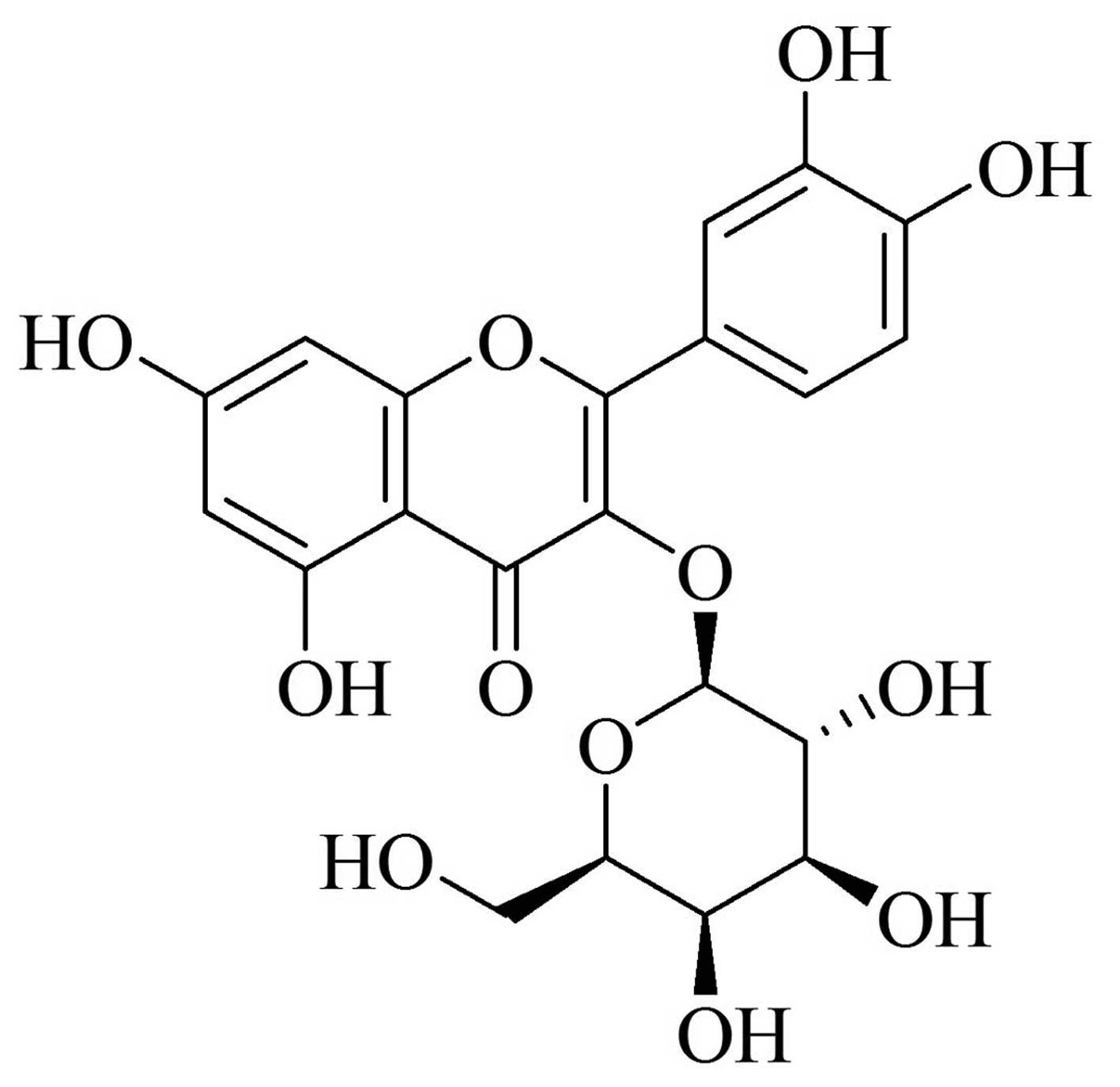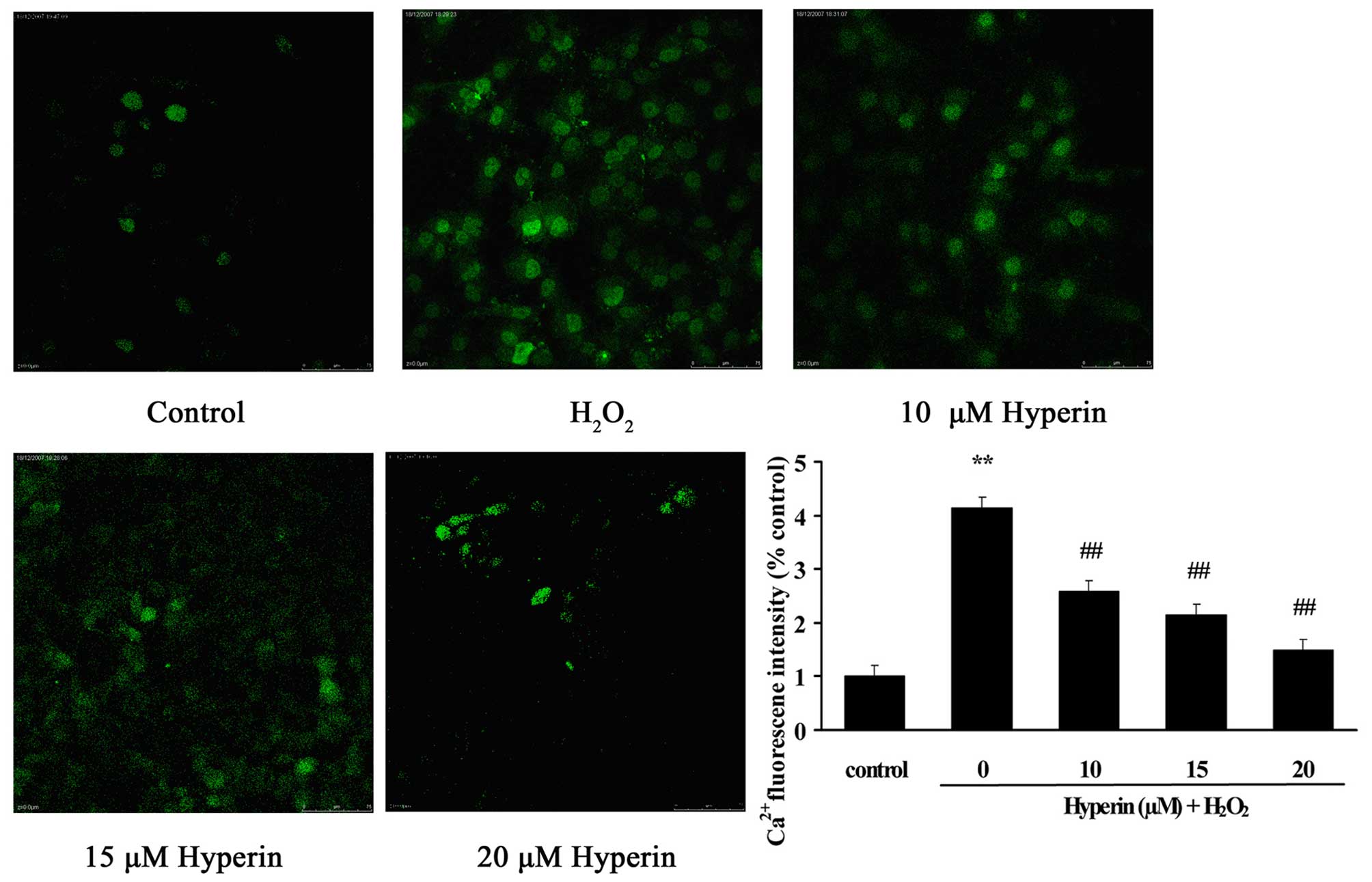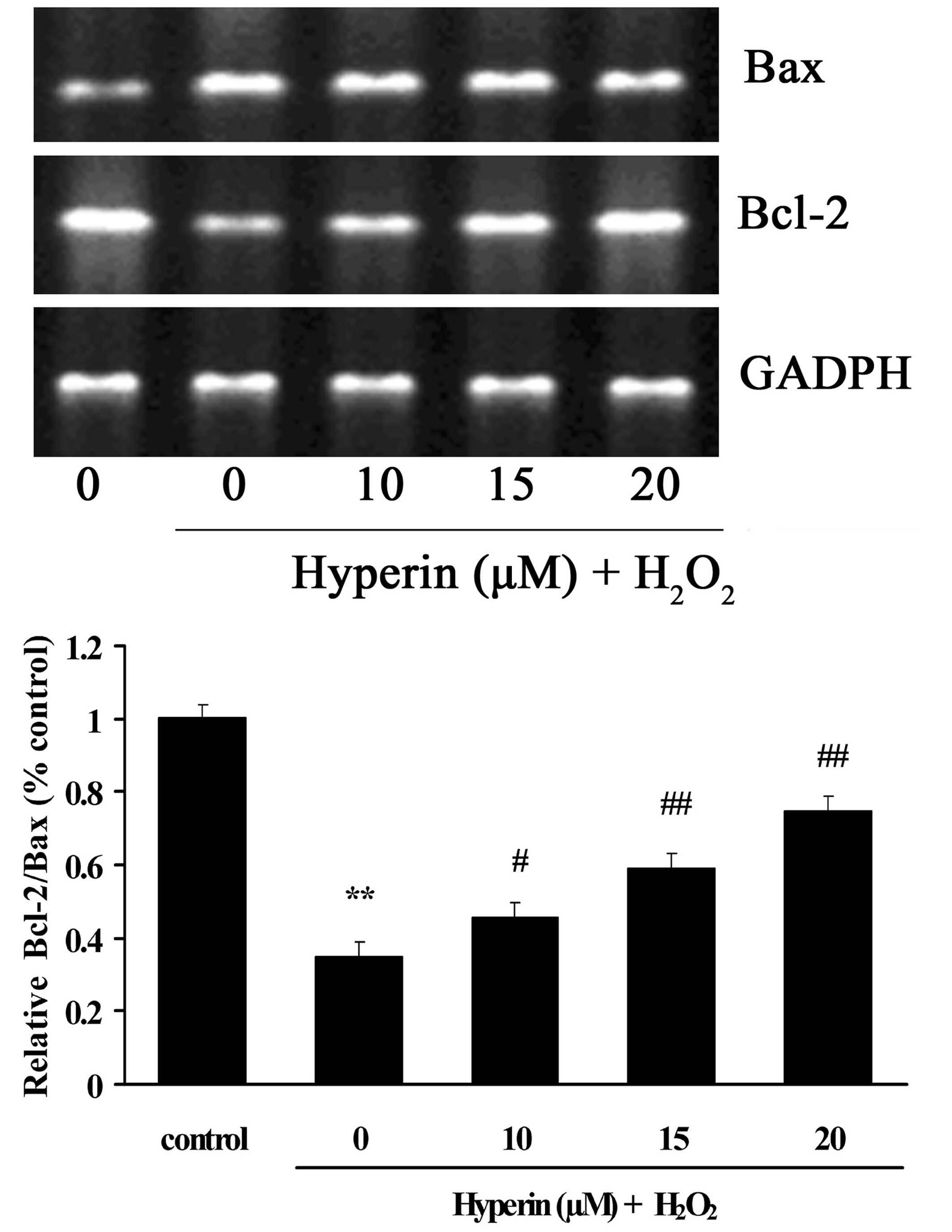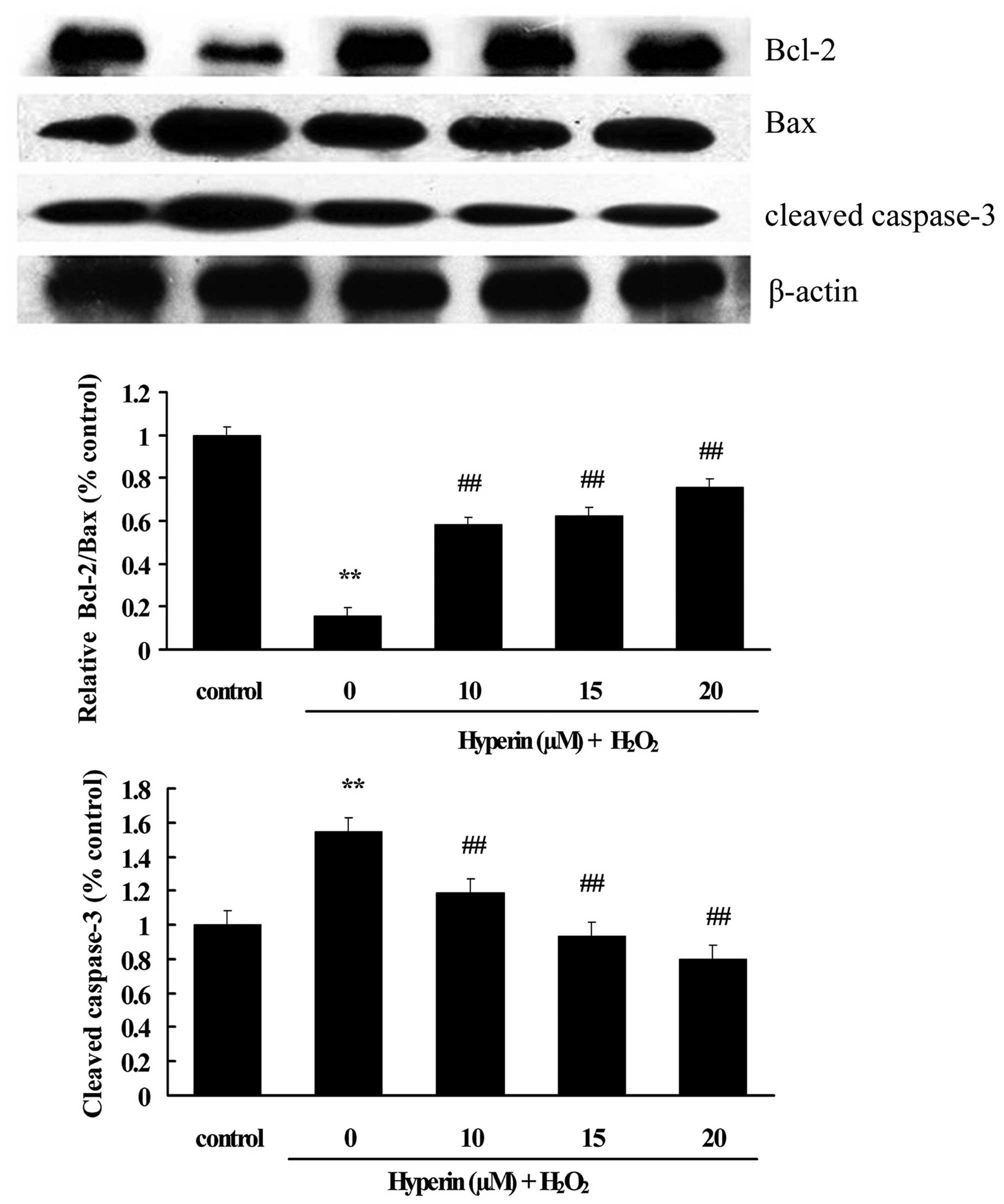Protective effects of hyperoside against H2O2-induced apoptosis in human umbilical vein endothelial cells
- Authors:
- Published online on: May 10, 2016 https://doi.org/10.3892/mmr.2016.5235
- Pages: 399-405
Abstract
Introduction
The vascular endothelium is a physiological barrier separating the circulating blood from the underlying tissue, and serves an important role in maintaining physiological homeostasis of blood vessels (1). Endothelial cell injury induced by oxidative stress, which is initiated by excessive generation of reactive oxygen species (ROS) in response to diverse extracellular detrimental stimuli, is involved in the pathogenesis of several diseases, including coronary heart disease, neurodegenerative disorders, diabetes, arthritis, inflammation and cancer (2–5). Therefore, the protection of endothelial cells against ROS-induced damage must be considered as an important strategy for intervention in cardiovascular diseases.
Apocynum venetum L. (Luo-Bu-Ma) is a traditional Chinese herbal medicine exhibiting diverse activities, including inhibition of platelet aggregation and myocardial ischemia/reperfusion injury, hypotension and an antioxidative effect, and is widely used for the prevention of cardiovascular diseases (6–10). Hyperoside (Fig. 1), a flavonoid, is the predominant active component abundant in A. venetum. Increasing evidence has demonstrated that hyperoside exhibits anti-inflammatory, antioxidative and cellular protective effects. Ku et al (11) reported that hyperoside exhibited anti-inflammatory effects via the regulation of the high-mobility group box (HMGB)1-mediated signaling pathway and was beneficial for the inhibition of vascular inflammation diseases (11). It was also reported that hyperoside has a powerful capacity to modulate oxidative stress-induced melanogenesis through the inhibition of the formation of peroxynitrite, O2 and NO in B16F10 melanoma cells (12). Numerous previous studies also indicated that hyperoside exerted protective effects on oxidative stress-induced injury of several types of cell (13–17). The present study demonstrated the protective effects of hyperoside against H2O2-induced apoptosis of HUVECs through the detection of endothelial Ca2+ content, expression levels of B-cell lymphoma (Bcl)-2, Bcl-2 associated X protein (Bax) and cleaved caspase-3, which was performed to investigate whether hyperoside was involved in the prevention of cardiovascular diseases.
Materials and methods
Materials
Hyperoside was purchased from the Chinese Food and Drug Inspection Institute (Beijing, China). Dimethyl sulfoxide (DMSO), 4% paraformaldehyde, H2O2 and 3-(4,5-dimethylthiazol-2-yl)-2,5-dephenyltetrazolium bromide (MTT) were obtained from Sigma-Aldrich Chemical Co. (St. Louis, MO, USA). Dulbecco's modified Eagle's medium (DMEM), L-glutamine, penicillin and streptomycin, and TRIzol reagent were purchased from Thermo Fisher Scientific, Inc. (Waltham, MA, USA). The bicinchoninic acid (BCA) assay kit and cridine orange/ethidium bromide (AO/EB) were purchased from Beyotime Institute of Biotechnology, Inc. (Nanjing, China). Antibodies against phosphorylated (p-)p38 (#9211), p38 (#9212), Bcl-2 (#2876), Bax (#2772) and cleaved-caspase-3 (#9661) were obtained from Cell Signaling Technology, Inc. (Beverly, MA, USA). Horseradish peroxidase (HRP)-conjugated goat anti-rabbit secondary antibody (#CW0103) and β-actin (#CW0097) were purchased from CoWin Biotech Co., Ltd. (Beijing, China). H2O2 was prepared freshly for each experiment from a 33% (v/v) stock solution. All other chemicals and reagents were commercially available and of standard biochemical quality.
Cell culture and treatments
The HUVEC line was purchased from the Cell Bank of the Chinese Academy of Sciences (Shanghai, China). The cells were cultured in DMEM supplemented with 10% heat-inactivated fetal bovine serum (FBS), and 0.1% penicillin/streptomycin at 37°C in 5% CO2. For all experiments, HUVECs were grown to 70–80% confluence and were subsequently treated as designed for different experiments.
Cell viability analysis
MTT assays were used to evaluate cell viability. HUVECs were seeded into 96-well plates at a density of 1×104 cells/well and cultured at 37°C for 24 h. The culture medium was then removed and fresh medium for different treatments was added to each well. Following treatment, 10 µl of 5 mg/ml MTT solution was added to each well and the cells were incubated for another 4 h. The culture medium was subsequently replaced with 100 µl DMSO. The optical density in each well was determined using a Bio-Rad Microplate Reader (Model 680; Bio-Rad Laboratories, Inc., Hercules, CA, USA) at 570 nm.
Assessment of apoptosis using AO/EB fluorescent staining
The cells were seeded at 5×105 cells/well in 6-well plates and cultured for 24 h. The cells were subsequently treated with hyperoside for 24 h prior to exposure to H2O2 for 4 h. The cells were fixed with 4% formaldehyde in phosphate-buffered saline (PBS) for 10 min and were washed with ice-cold PBS three times. The cells were stained with AO/EB solution (5 µl) for 30 sec and changes in cell morphology were observed using a fluorescence microscope (Olympus IX-71; Olympus, Tokyo, Japan).
Assessment of intercellular Ca2+ levels
The cells were seeded at a density of 5×105 cells/well into 6-well plates and were cultured for 24 h. The cells were subsequently treated with hyperoside for 24 h prior to exposure to H2O2 for 4 h. The Fluo-3/AM fluorescent probe was added to the HUVEC suspension at a final concentration of 10 µM and incubated at 37°C for 40 min. The intracellular Ca2+ content in the HUVECs was subsequently measured with laser-scanning confocal microscopy (Olympus FV1000, Olympus) with an excitation wavelength of 488 nm and a measured emission at 530 nm.
Reverse transcription-polymerase chain reaction (RT-PCR)
The total RNA was extracted from the HUVECs using TRIzol reagent, according to the manufacturer's protocol. The concentration of purified RNA samples were measured spectrophotometrically using a Picodrop (Picodrop Ltd., Walden, UK). The RT reaction was performed using a SuperScript III First-Strand Synthesis system (Thermo Fisher Scientific, Inc.), according to the manufacturer's protocol. Amplification of the RT product by PCR was performed using Promega Taq DNA Polymerase (Promega Co., Madison, WI, USA). All reactions were performed in a thermal cycler (Model 2400; Perkin-Elmer, Norwalk, CT, USA) with primers (Sangon Biotech Co., Ltd., Shanghai, China) specific for Bcl-2, forward: 5′-CTT CGC CGA GAT GTC CAG CCA-3′ and reverse: 5′-CGC TCT CCA CAC ACA TGA CCC-3′; Bax, forward: 5′-TGC TTC AGG GTT TCA TCC AGGA-3′ and reverse: 5′-ACG GCG GCA ATC ATC ATC CTC TG-3′; glyceraldehyde-3-phosphate dehydrogenase (GAPDH), forward: 5′-TCT CTG CTC CTC CTG TTC GAC-3′ and reverse: 5′-TTA AAA GCA GCC CTG GTG AC-3′. Thermal cycling conditions involved an initial denaturation step at 94°C for 10 min, followed by 30 cycles of denaturation at 94°C for 10 sec, and primer annealing at 60°C for 1 min, which was followed by agarose gel electrophoresis.
Quantitation of protein samples
Following treatment with various concentrations of hyperoside prior to H2O2 exposure, the HUVECs were washed with ice-cold PBS and harvested by trypsinization. The cells were centrifuged (1,000 rpm for 5 min) and washed with ice-cold PBS three times. The cells were then suspended in 100 µl ice-cold radioimmunoprecipitation lysis buffer (Beyotime Institute of Biotechnology, Inc.), sonicated 10 times for 5 sec with 10 sec pauses in an ice-water bath, and the samples were centrifuged (13,000 rpm for 5 min at 4°C). The supernatants were stored at −80°C. Quantification of the protein was performed using a BCA assay.
Western blot analysis
Equal quantities of protein extracts (40 µg) were separated on 12% sodium dodecyl sulfate-polyacrylamide gels. The proteins were subsequently transferred onto nitrocellulose membranes (Pall Gelman Laboratory Corporation, Ann Arbor, MI, USA). The membranes were blocked with 5% (w/v) non-fat milk powder in Tris-buffered saline/0.1% Tween-20 (TBST) for 1.5 h at room temperature. Following blocking, the membranes were incubated overnight at 4°C with the primary antibody (dilution, 1:1,000). After three washes with TBST, the membranes were incubated for 1 h with horseradish peroxidase (HRP)-conjugated anti-rabbit immunoglobulin G as the secondary antibody at room temperature (dilution, 1:2,000). After three washes, the proteins were detected using an enhanced chemiluminescence detection kit (CoWin Biotech Co., Ltd., Beijing, China).
Statistical analysis
The data are presented as the mean ± standard deviation. Statistical comparisons were performed using a Student's t-test, and the differences between multiple groups were assessed by one-way analysis of variance. P<0.05 was considered to indicate a statistically significant difference.
Results
Effects of hyperoside on the viability of HUVECs
To evaluate the apoptotic induction of H2O2 on HUVECs, HUVECs were incubated with 200 µM H2O2 for different durations. As shown in Fig. 2A, the viability of HUVECs decreased ~50% following exposure to 200 µM H2O2 for 4 h. Therefore, the exposure of HUVECs to 200 µM H2O2 for 4 h was selected to induce apoptosis of HUVECs for the subsequent experiments.
To ensure the suitable concentrations of hyperoside, the cytotoxicity of hyperoside was evaluated by MTT assay. HUVECs were cultured with various concentrations of hyperoside for 24 h and the cell viability was assessed. The result revealed that hyperoside at concentrations of <20 µM caused no affect the viability of HUVECs, as shown in Fig. 2B. Therefore, the concentrations of hyperoside were confirmed as 10, 15 and 20 µM in the subsequent experiments.
As shown in Fig. 2C, the H2O2-induced decrease of cell viability was significantly attenuated by hyperoside treatment in a dose-dependent manner (P<0.01), which suggested that hyperoside exhibited protective effect on H2O2-induced HUVECs injury.
Effects of hyperoside on H2O2-induced apoptosis in HUVECs
As shown in Fig. 3, AO/EB staining demonstrated that exposure of HUVECs to 200 µM H2O2 for 4 h induced HUVEC apoptosis. However, the treatment of HUVECs with 10, 15 and 20 µM hyperoside significantly attenuated the apoptosis of HUVECs induced by H2O2, which demonstrated that hyperoside exhibited anti-apoptosis effects in H2O2-induced HUVECs.
Effects of hyperoside on intercellular Ca2+ levels in HUVECs
As shown in Fig. 4, compared with the control group, intercellular Ca2+ content, presented as the fluorescence intensity, was significantly overloaded in the H2O2-induced HUVECs (P<0.01). However, the treatment of HUVECs with different concentrations of hyperoside (10, 15 and 20 µM) significantly inhibited the increase of fluorescence intensity induced by H2O2 in a dose-dependent manner (P<0.01). This indicated that hyperoside exhibited protective effects on the oxidative stress-induced increase of intercellular Ca2+ content.
Effects of hyperoside on the mRNA expression levels of Bcl-2 and Bax
As shown in Fig. 5, the mRNA expression of Bax was significantly increased in the H2O2-induced group. By contrast, the mRNA expression of Bcl-2 was significantly decreased compared with the control group. However, different concentrations of hyperoside (10, 15 and 20 µM) exhibited significant inhibition on the H2O2-induced increase of Bax and decrease of Bcl-2 mRNA in a dose-dependent manner (P<0.01).
Effects of hyperoside on the expression of apoptotic-associated proteins
As shown in Figs. 6 and 7, compared with the control group, the expression of cleaved caspase-3, Bax and p-p38 was significantly increased, while Bcl-2 was significantly decreased, in the H2O2-induced group. However, the treatment with different concentrations of hyperoside (10, 15 and 20 µM) revealed a significant inhibition on the H2O2-induced increase of cleaved caspase-3, Bax and p-p38, and the decrease of Bcl-2 in a dose-dependent manner (P<0.01). This indicated that hyperoside exhibited antiapoptotic effects on H2O2-induced HUVECs.
Discussion
Apocynum venetum L., known as Luobuma in China, is a traditional Chinese herb exhibiting diverse activities, including inhibition of platelet aggregation and myocardial ischemia/reperfusion injury, hypotension and antioxidative effect, and is widely used for the prevention of cardiovascular diseases. Chemical studies have demonstrated that flavonoids were rich in A. venetum, including quercetin, kaempferol, rutin and hyperoside (10). Increasing evidence has demonstrated that hyperoside exhibited anti-inflammatory, antioxidative and cellular protective effects. The present study demonstrated the protective effects of farrerol against oxidative stress-induced apoptosis in HUVECs.
A previous study demonstrated that the elevation of intracellular Ca2+ concentration was involved in the induction of mitochondrial dysfunction and leads to mitochondria-dependent apoptosis (18). Chen et al (19) also reported that hyperoside can inhibit Ca2+ influx in dissociated neonatal rat brain cells (19). The present study found that hyperoside exhibited the inhibition of H2O2-induced increase of intercellular Ca2+ concentration in HUVECs, suggesting a protective effect of hyperoside on H2O2-induced HUVEC injury.
The Bcl-2 protein family is essential in the mitochondrial apoptosis pathway. This protein family can be divided into two categories: i) Anti-apoptotic members, including Bcl-2 and Bcl-xl; ii) pro-apoptotic members, including Bax and Bak. Numerous previous studies have demonstrated that the ratio of Bcl-2/Bax determines the fate of cells to apoptosis or survival. The decrease of Bcl-2/Bax induced the increase of mitochondrial permeability and the release of cytochrome c, which resulted in the activation of caspase-3 and apoptosis (20–24). The present study revealed that hyperoside increased the mRNA and protein expression levels of Bcl-2 and decreased the expression of Bax in the H2O2-induced HUVECs, indicating the antiapoptotic effects of hyperoside on H2O2-induced apoptosis of HUVECs.
Caspase components are central in the execution of apoptosis (25). Caspase-3, which mediates apoptosis for both extrinsic and intrinsic pathways, is cleaved and activated in the process of apoptosis. The present study detected the effect of hyperoside on the expression of cleaved csspase-3 by western blotting. The result indicated that hyperoside inhibited the increased expression of cleaved caspase-3 induced by H2O2 in HUVECs, which demonstrated the antiapoptotic effect of hyperoside on oxidative stress-induced HUVEC apoptosis.
Increasing evidence has indicated that exposure of the cells to H2O2 induces the activation of the members of the mitogen-activated protein kinase (MAPK) pathway, including extracellular signal-regulated kinases (ERK) 1/2, c-jun NH2-terminal kinases (JNK) and p38 kinase (26). Among these kinases, the JNK and p38 pathways are commonly considered to be apoptotic, whereas ERK1/2 is associated with protection from apoptosis (27). The present research indicated that the hyperoside regulated the activation of p38 MAPK induced by H2O2 in HUVECs, which demonstrated that the antiapoptotic effect of hyperoside was likely associated with its regulation of the p38 MAPK signaling pathway.
In conclusion, the present study demonstrated that hyperoside protected HUVECs from H2O2-induced apoptosis, which was likely associated with the regulation of hyperoside on intracellular Ca2+ content, expression of apoptosis-associated proteins (Bcl-2, Bax and Cleaved caspase-3) and activation of the p38 MAPK. The findings suggested that hyperoside protected cells from oxidative stress-induced injury, which was likely associated with the prevention of cardiovascular diseases.
Acknowledgments
The present study was financially supported by the National Natural Science Foundation of China (nos. 81274132 and 81172938), and the Top Science and Technology Innovation Teams of Higher Learning Institutions of Shanxi Province.
References
|
Deanfield JE, Halcox JP and Rabelink TJ: Endothelial function and dysfunction: Testing and clinical relevance. Circulation. 115:1285–1295. 2007.PubMed/NCBI | |
|
Matés JM and Sánchez-Jiménez FM: Role of reactive oxygen species in apoptosis: Implications for cancer therapy. Int J Biochem Cell Biol. 32:157–170. 2000. View Article : Google Scholar : PubMed/NCBI | |
|
Harrison D, Griendling KK, Landrnesser U, Hornig B and Drexler H: Role of oxidative stress in atherosclerosis. Am J Cardiol. 91:7A–11A. 2003. View Article : Google Scholar : PubMed/NCBI | |
|
Choy JC, Granville DJ, Hunt DW and McManus BM: Endothelial cell apoptosis: Biochemical characteristics and potential implications for atherosclerosis. J Mol Cell Cardiol. 33:1673–1690. 2001. View Article : Google Scholar : PubMed/NCBI | |
|
Cai H and Harrison DG: Endothelial dysfunction in cardiovascular diseases: The role of oxidant stress. Circ Res. 87:840–844. 2000. View Article : Google Scholar : PubMed/NCBI | |
|
Kasimu R, Fan Z, Wang X, Hu J, Wang P and Wang J: Anti-platelet aggregation activities of different fractions in leaves of Apocynum venetum L. J Ethnopharmacol. 168:116–121. 2015. View Article : Google Scholar : PubMed/NCBI | |
|
Wang W, Liang X, Fu D, Tie R, Xing W, Ji L, Liu F, Zhang H and Li R: Apocynum venetum leaf attenuates myocardial ischemia/reperfusion injury by inhibiting oxidative stress. Am J Chin Med. 43:71–85. 2015. View Article : Google Scholar : PubMed/NCBI | |
|
Lau YS, Kwan CY, Ku TC, Hsieh WT, Wang HD, Nishibe S, Dharmani M and Mustafa MR: Apocynum venetum leaf extract, an antihypertensive herb, inhibits rat aortic contraction induced by angiotensin II: A nitric oxide and superoxide connection. J Ethnopharmacol. 143:565–571. 2012. View Article : Google Scholar : PubMed/NCBI | |
|
Chen HY, Wang JH, Geng M, Wu XQ, Yan L, Huang K, Shao LM, Yang XB and Huang ZM: Protective effect of extract of Apocynum venetum on kidneys of streptozotocin-induced diabetic rats. Yao Xue Xue Bao. 45:26–30. 2010.In Chinese. | |
|
Xie W, Zhang X, Wang T and Hu J: Botany, traditional uses, phytochemistry and pharmacology of Apocynum venetum L. (Luobuma): A review. J Ethnopharmacol. 141:1–8. 2012. View Article : Google Scholar : PubMed/NCBI | |
|
Ku SK, Zhou W, Lee W, Han MS, Na M and Bae JS: Anti-inflammatory effects of hyperoside in human endothelial cells and in mice. Inflammation. 38:784–799. 2015. View Article : Google Scholar | |
|
Kim YJ: Hyperoside and quercetin modulate oxidative stress-induced melanogenesis. Biol Pharm Bull. 35:2023–2027. 2012. View Article : Google Scholar | |
|
Liu Z, Tao X, Zhang C, Lu Y and Wei D: Protective effects of hyperoside (quercetin-3-o-galactoside) to PC12 cells against cytotoxicity induced by hydrogen peroxide and tert-butyl hydroperoxide. Biomed Pharmacother. 59:481–490. 2005. View Article : Google Scholar : PubMed/NCBI | |
|
Li HB, Yi X, Gao JM, Ying XX, Guan HQ and Li JC: The mechanism of hyperoside protection of ECV-304 cells against tert-butyl hydroperoxide-induced injury. Pharmacology. 82:105–113. 2008. View Article : Google Scholar : PubMed/NCBI | |
|
Ju HY, Chen SC, Wu KJ, Kuo HC, Hseu YC, Ching H and Wu CR: Antioxidant phenolic profile from ethyl acetate fraction of Fructus Ligustri Lucidi with protection against hydrogen peroxide-induced oxidative damage in SH-SY5Y cells. Food Chem Toxicol. 50:492–502. 2012. View Article : Google Scholar | |
|
Liu RL, Xiong QJ, Shu Q, Wu WN, Cheng J, Fu H, Wang F, Chen JG and Hu ZL: Hyperoside protects cortical neurons from oxygen-glucose deprivation-reperfusion induced apoptosis via nitric oxide signal pathway. Brain Res. 1469:164–173. 2012. View Article : Google Scholar : PubMed/NCBI | |
|
Li ZL, Liu JC, Hu J, Li XQ, Wang SW, Yi DH and Zhao MG: Protective effects of hyperoside against human umbilical vein endothelial cell damage induced by hydrogen peroxide. J Ethnopharmacol. 139:388–394. 2012. View Article : Google Scholar | |
|
Tornero D, Posadas I and Ceña V: Bcl-x(L) blocks a mitochondrial inner membrane channel and prevents Ca2+ overload-mediated cell death. Plos One. 6:e204232011. View Article : Google Scholar | |
|
Chen ZW and Ma CG: Effects of hyperoside on free intracellular calcium in dissociated neonatal rat brain cells. Zhongguo Yao Li Xue Bao. 20:27–30. 1999.PubMed/NCBI | |
|
Burlacu A: Regulation of apoptosis by Bcl-2 family proteins. J Cell Mol Med. 7:249–257. 2003. View Article : Google Scholar : PubMed/NCBI | |
|
Cory S and Adams JM: The Bcl-2 family: Regulators of the cellular life-or-death switch. Nat Rev Cancer. 2:647–656. 2002. View Article : Google Scholar : PubMed/NCBI | |
|
Antonsson B: Mitochondria and the Bcl-2 family proteins in apoptosis signaling pathways. Mol Cell Biochem. 256–257:141–155. 2004. View Article : Google Scholar | |
|
Hetz C, Bernasconi P, Fisher J, Lee AH, Bassik MC, Antonsson B, Brandt GS, Iwakoshi NN, Schinzel A, Glimcher LH and Korsmeyer SJ: Pro-apoptotic Bax and Bak modulate the unfolded protein response by a direct interaction with IRE1alpha. Science. 312:572–576. 2006. View Article : Google Scholar : PubMed/NCBI | |
|
Youle RJ and Strasser A: The Bcl-2 protein family: Opposing activities that mediate cell death. Nat Rev Mol Cell Biol. 9:47–59. 2008. View Article : Google Scholar | |
|
Riedl SJ and Shi YG: Molecular mechanisms of caspase regulation during apoptosis. Nat Rev Mol Cell Biol. 5:897–907. 2004. View Article : Google Scholar : PubMed/NCBI | |
|
Runchel C, Matsuzawa A and Ichijo H: Mitogen-activated protein kinases in mammalian oxidative stress responses. Antioxid Redox Signal. 15:205–218. 2011. View Article : Google Scholar | |
|
Xia Z, Dickens M, Raingeaud J, Davis RJ and Greenberg ME: Opposing effects of ERK and JNK-p38 MAP kinases on apoptosis. Science. 270:1326–1331. 1995. View Article : Google Scholar : PubMed/NCBI |
















